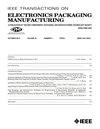Ultrasonic Bonding Using Anisotropic Conductive Films (ACFs) for Flip Chip Interconnection
IEEE Transactions on Electronics Packaging Manufacturing
Pub Date : 2009-08-28
DOI:10.1109/TEPM.2009.2027894
引用次数: 20
Abstract
In this paper, a novel anisotropic conductive film (ACF) flip chip bonding method using ultrasonic vibration for flip chip interconnection is demonstrated. The curing and bonding behaviors of ACFs by ultrasonic vibration were investigated using a 40-kHz ultrasonic bonder with longitudinal vibration. In situ temperature of the ACF layer during ultrasonic (U/S) bonding was measured to investigate the effects of substrate materials and substrate temperature. Curing of the ACFs by ultrasonic vibration was investigated by dynamic scanning calorimetry (DSC) analysis in comparison with isothermal curing. Die adhesion strength of U/S-bonded specimens was compared with that of thermo-compression (T/C) bonded specimens. The temperature of the ACF layer during U/S bonding was significantly affected by the type of substrate materials rather than by the substrate heating temperature. With room the temperature U/S bonding process, the temperature of the ACF layer increased up to 300degC within 2 s on FR-4 substrates and 250degC within 4 s on glass substrates. ACFs were fully cured within 3 s by ultrasonic vibration, because the ACF temperature exceeded 300degC within 3 s. Die adhesion strengths of U/S-bonded specimens were as high as those of T/C bonded specimens both on FR-4 and glass substrates. In summary, U/S bonding of ACF significantly reduces the ACF bonding times to several seconds, and also makes bonding possible at room temperature compared with T/C bonding which requires tens of seconds for bonding time and a bonding temperature of more than 180degC.利用各向异性导电膜(ACFs)进行倒装芯片互连的超声键合
本文提出了一种利用超声振动实现各向异性导电膜(ACF)倒装芯片连接的新方法。采用40 khz纵向振动超声键合机,研究了ACFs在超声振动下的固化和键合行为。测量了超声(U/S)键合过程中ACF层的原位温度,研究了衬底材料和衬底温度对ACF层原位温度的影响。采用动态扫描量热法(DSC)对ACFs的超声固化进行了研究,并与等温固化进行了比较。比较了U/ s粘结试样与热压(T/C)粘结试样的模具粘接强度。在U/S键合过程中,ACF层的温度受衬底材料类型的影响显著,而不受衬底加热温度的影响。室温U/S键合过程中,在FR-4基板上ACF层的温度在2 S内上升到300℃,在玻璃基板上的温度在4 S内上升到250℃。超声振动使ACF在3 s内完全固化,因为ACF温度在3 s内超过300℃。U/ s键合试样在FR-4和玻璃基板上的模具附着力均高于T/C键合试样。综上所述,ACF的U/S键合可以将ACF的键合时间显著缩短到几秒,并且可以在室温下键合,而T/C键合需要几十秒的键合时间和180℃以上的键合温度。
本文章由计算机程序翻译,如有差异,请以英文原文为准。
求助全文
约1分钟内获得全文
求助全文

 求助内容:
求助内容: 应助结果提醒方式:
应助结果提醒方式:


